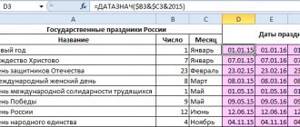Calculation of average earnings for compensation upon dismissal in 2019
- The total amount of accrued labor income for the last 12 months of the employee’s work is calculated. If he works for less than a year, then payments are calculated for the actual period.
- The resulting amount of income is divided into 12 months. In the case where the new employee does not have a full year of work, the number of months for which the employee actually worked is used.
- The resulting average monthly salary must be divided by 29.3. As a result, the SDZ will be determined.
- Compensation for vacation is not included in the register of tax-exempt payments; accordingly, personal income tax must be withheld (clause 3 of Article 217 of the Tax Code of the Russian Federation).
- Dismissal benefits due to liquidation or reduction in the number of full-time employees are not subject to personal income tax. An exception will be the moment when the entire amount of payments is more than 3-6 average monthly earnings. In such cases, this tax should be withheld from the excess (clause 3 of Article 217 of the Tax Code of the Russian Federation as amended by Law No. 330-FZ).
Legislative norms
When making calculations, you must be guided by the rules specified in Article 139 of the Labor Code of the Russian Federation. It describes in detail how you need to act in order to get the average earnings necessary to make calculations upon dismissal.
In Government Decree No. 922, adopted on December 24. 2007 discusses in detail various situations that may arise during such calculations and explains how to proceed in certain cases.
The number of working days for the period under review is specified in Federal Law No. 55-FZ.
How to calculate average daily earnings when calculating compensation upon dismissal
Decree of the Government of the Russian Federation dated July 10, 2014 N 642) If one or more months of the billing period are not fully worked out or time is excluded from it in accordance with paragraph 5 of these Regulations, the average daily earnings are calculated by dividing the amount of actually accrued wages for the billing period by the sum of the average monthly number of calendar days (29.3), multiplied by the number of complete calendar months, and the number of calendar days in incomplete calendar months.
(as amended by Decree of the Government of the Russian Federation dated July 10, 2014 N 642) The number of calendar days in an incomplete calendar month is calculated by dividing the average monthly number of calendar days (29.3) by the number of calendar days of this month and multiplying by the number of calendar days falling on the time worked out in a given month. (edited)
Decrees of the Government of the Russian Federation dated July 10, 2014 N 642) 11.
How to calculate average earnings upon dismissal
In different cases, compensation can be paid either as a lump sum - for 1 or 2 months, or monthly for 4 or even 6 months. It all depends on the category of the employee, the region in which he worked (the longest terms for payment of compensation are in the Far North), and a number of other factors. The amount of compensation is determined by multiplying the SDZ by the number of days for which it must be paid. Methodology How to calculate average earnings upon dismissal? The calculation uses the sum of all income that the employee received directly for performing work duties for a certain time. If an employee has worked for the company for more than a year, the billing period will be 12 months. If it is less, the time actually worked by him and all payments he received, including salary, bonus, bonus for harmfulness and length of service, etc., are taken into account.
How is the period of unspent vacation paid upon dismissal?
Knowing your average salary for the year, if you have worked for less than a year, it is quite possible to calculate the due compensation for the next leave upon dismissal.
To do this, first of all, keep in mind that to accrue the days required by law for vacation, it is not the calendar year that is taken, but the year in which you worked at this enterprise.
For example, let’s take, if you got a job in an organization, say, on May 20, 2015, then the full working year, when you will already be entitled to a full vacation of 28 days, came on May 19, 2016.
To calculate the length of service, which is taken into account when determining the right to grant leave, the days when you were on sick leave due to temporary disability or took part of the leave are taken into account.
The time when you were on free leave, on maternity leave, if there were days of absenteeism from work, that is, those days when the average salary was not retained by law for you, is not considered as length of service giving the right to paid leave.
If you have worked for more than half a month, this time will also be included in the length of service for accruing vacation. If less, it is not taken into account.
This calculation of length of service when calculating vacation is carried out on the basis of the explanations given in Letter of the Ministry of Labor No. 944 - 6 dated June twenty-third, 2006.
In order to determine how many days you are entitled to for the period worked, if you worked for less than a year, you need to multiply the number of these months by a factor of 2.33.
The resulting number is always rounded up.
For example, you worked for four months:
4 months X 2.33 = 9.32 days.
This means that you must be compensated for 10 days of vacation that you earned for the time you worked.
These days, in this case 10 days, are multiplied by the average wage per day and the amount of compensation due is obtained.
If you are one month short of a working year before leaving the company, that is, you have worked a total of eleven months, compensation must be paid for all twenty-eight days of vacation provided by law, if you did not use rest days during this time.
In the event that you managed to take some part of the allotted leave off, this number of days is deducted from the allotted time that you earned at the time of dismissal.
So, for example, at the time of dismissal you had worked for 11 months at this enterprise, but after five months of your work, you took 3 days of rest towards your next vacation.
This means that upon dismissal you will be compensated for 28 days (entitled vacation days) - 3 days (days that you used) = 25 days (the number of vacation days for which you are entitled to compensation).
Dismissal during the liquidation of an enterprise or if your position is reduced, even after working for 5.5 months at this enterprise, gives the right to receive compensation for all twenty-eight days of legally paid leave, in accordance with the twenty-eighth paragraph of the “Rules on regular and additional leaves”, as amended dated April 20, 2010.
Regardless of the total length of service at the enterprise at the time of dismissal, compensation is due for unused days of the next vacation, although you have the right to go on vacation while working at the enterprise after six months.
To calculate average earnings, social payments are not taken into account; these include: material assistance, payment for special meals, utilities, for employees living in service apartments, as well as payments that are made based on average earnings.
According to the law, sick leave, time on business trips, and regular vacations are paid based on the amount of average earnings.
Consequently, the answer to the question of whether vacation pay is included in the calculation of average earnings upon dismissal is unequivocal - no, they are not.
Formulas and examples for calculating SDZ
The procedure for calculating average daily earnings directly depends on how much time a person has worked at the enterprise, and therefore, when calculating the SDZ, it is necessary to be based on two indicators, these include:
- Total payments received in the performance of official duties minus income that is not included in the calculation of SDZ (payments for vacation, sick leave, business trips, etc.). Here, the division by calculation algorithms depends on the length of employment at a given enterprise:
- When an employee works for a company for 12 months or more, the calculation includes payments for the previous 12 months before the date of dismissal.
- If a person joined the company less than a year ago, the entire period of his work in the organization (from the first day) is taken, with the exception of the month of dismissal.
- The second indicator is the period worked, again minus the standard excluded situations for SDZ. And there are several nuances here:
- When calculating compensation for a person resigning, when he has worked for more than a year and there were no periods that cannot be included in the calculation of SDZ, 12 full months before the month of dismissal are taken.
- If the person leaving the job worked in the company for less than a year or there were excluded periods in his work experience during the year, the calculation of average earnings includes the days of the first incomplete month of work or the days of the month with excluded periods in certain months. The pay period ends with the last full month before the date of dismissal.
Accordingly, the formulas for calculating average daily earnings will be as follows:
- If the work experience is more than a year and taking into account the fact that there were no unaccounted periods, the SPA will be calculated according to the algorithm - ∑ (amount of earnings for 12 months) / 12 / 29.3 (fixed coefficient) = SPA. For example, if the sum of all payments taken into account in the calculation to an employee for 12 months was 800,000 rubles, then the formula will look like this: 800,000 rubles/12/29.3 = 2,275.31 rubles (SDZ).
- Provided that there were periods in the calculation period that should not be included in the SDZ indicator, the calculation will be more complex. For example, for the period from October 1, 2021 to September 30, 2018, a person (with the same 800,000 rubles of all payments included in the calculation of payments) was sick and was on the ballot 2 times, in February for 14 days and in May for 5 days. We count:
- We determine the number of full months - 10 months.
- We calculate the remaining days worked in partial months. In this case, weekends are not taken into account in the calculation of the b/l sheet, that is, in February the number of days will be equal to - 29.3 / 28 days of February (28 days - 14 days by b/l + 4 days of which are weekends) = 18.84 days . In May, according to the calculation, the formula will be - 29.3 / 31 days of May (31 days - 5 days on a weekly basis + 2 days of which are weekends) = 26.46 days.
- The final calculation of SDZ is 800,000 ₽ / (29.3 x 10 full months + 18.84 days worked in February + 26.46 days of May) = 2,364.77 ₽ (SDZ). Here, workers should not delude themselves that if they have unpaid sheets, the average earnings will be higher; this is not entirely true in this case. If you compare equal amounts of monthly salaries, then the total amount of payments may be less under certain conditions.
- If the employee’s length of service does not reach a full year, then a formula is taken that takes into account the days of the first incomplete month of work and the full months worked - ∑ (amount of remuneration for all full months of work, taking into account excluded periods) / 29.3 x number of fully worked months + number days in an incomplete month worked. Let’s take the same 800,000 ₽, but received by the employee for 9 full months of work, as well as for 10 calendar days of the first incomplete month. The calculation will be as follows: 800,000 ₽ / (29.3 x 9 full months + 10 days worked) = 2,922.91 ₽.
- Let's consider a non-standard situation - an employee worked on a part-time schedule (part-time work week, day). Average daily earnings are calculated in this option by dividing the total actual payments of wages and other remunerations included in the calculation by the number of working days in a standard five-day working week. For example: an employee worked for 3 months and received 100,000 rubles for his work. We take the number of working days in these months according to the production calendar. So, in October 2021 there are 23 of them, in September - 20, in August - 23. We get the result according to SDZ: 100,000 ₽ / 66 working days in the billing period = 1,515.15 ₽.
An example of calculating compensation for unused vacation
Employee Fedorov V.A. hired at Solnyshko LLC on December 3, 2019, and left on May 25, 2021.
Fedorov was on vacation in July 2021 (28 cal. days). The employee did not have any periods not included in the vacation period. The calculation period for calculating compensation is 12 months preceding the month of dismissal, i.e. from May 2021 to April 2021. During this period, the employee earned 632,400 rubles.
Step 1 - calculate the length of service:
- from 03.12.2019 to 02.12.2020 - 12 months;
- from 12/03/2020 to 05/02/2021 - 5 months;
- from 05/03/2021 to 05/25/2021 - 22 days, which exceeds half a month, which means the full month is taken into account.
Total experience is 18 months
Step 2 - determine the number of vacation days from the start of work. 18 months x 2.33 = 42 days.
Step 3 - determine the number of days of unused vacation.
42 days - 28 days used = 14 days
Step 4 - calculate average daily earnings (ADE).
- the number of fully worked months in the billing period is 11;
- in incompletely worked August it is equal to 2.84 (29.3 / 31 days x (31 days - 28 days));
- SDZ is equal to 1,945 rubles. (RUB 632,400 / (29.3 x 11 months + 2.84 days)).
Step 5 - determine the amount of compensation for vacation.
RUB 1,945 x 14 days = 27,230 rub. When paying compensation, personal income tax must be withheld from it. Thus, Fedorov will receive 23,691 rubles. (RUB 27,230 - 13%).
Calculation of average daily earnings upon dismissal
Calculation period In the process of calculating the level of the average salary of an employee, the last twelve months of work before dismissal are taken into account in the process of determining the amount of compensation payment for unused vacation. There are the following features:
the last month of work is taken into account, accordingly, the calculation of average earnings upon dismissal on the last day of the month occurs in exactly the same way as if the employee quit on any other day; in situations where the calculation period includes any leave (annual paid leave, maternity leave, child care, etc.), the earlier period is taken into account.
Base One of the indicators necessary to calculate the average salary to determine the size of the compensation payment is the base.
It is the sum of all employee remunerations for the pay period.
Features of calculating the payroll period In practice, the problem arises of determining the payout period when dismissal on the last day of the month. The last month of work is included in the time period for calculating average earnings only if it is worked in full before the calendar date of its end.
Example: an employee quits on the last working day of January, which falls on the 30th. In this case, the billing period will be considered from January 1 to December 31. But if the dismissal date were January 31, then the average earnings should be calculated from February 1 of last year to January 31 of the current year. Accountants may also raise questions when a person who previously resigned from the organization is hired again for the same position and, after working for less than a year, decides to terminate the employment relationship. Labor Code of the Russian Federation);
- period of temporary disability (illness, caring for a loved one, pregnancy and childbirth);
- additional free days provided for caring for disabled children;
- downtime through no fault of the employee;
- a strike in which the employee did not take part, which interfered with the performance of his work duties;
- other periods provided for in clause 5 of the Regulations approved by Decree of the Government of the Russian Federation of December 24, 2007 No. 922.
Exclusion of certain amounts from total income Regardless of the exact time within the billing period the accruals were made, some of them are not taken into account when determining the average daily earnings (during the calculation of the total income for the billing period).
What payments are taken into account when determining average earnings
So, we found out that the calculation of average earnings for compensation upon dismissal in 2021 occurs in accordance with Resolution No. 922.
In order not to strain too much, you can use an online calculator for calculating average earnings upon dismissal, which will calculate your average monthly earnings for the period you specified in a matter of seconds with maximum accuracy.
He also takes into account when calculating the number of days that are not taken into account when calculating average earnings.
It is enough to enter the terms of the calculated period, the amount of salary, and other payments for the period of time that specifically interests you.
Let us dwell more specifically on the question of what is included in the average earnings when calculating compensation upon dismissal.
When calculating the average wage, all types of payments provided for by the wage system at each specific enterprise are taken into account.
- wages accrued at the tariff rate or salary established for certain specialties and positions;
- all kinds of monetary rewards and fees;
- salary supplements;
- additional payments provided in connection with a special regime or working conditions;
- bonuses and other monetary incentives for the calculated period.
When accounting for premiums paid, you need to keep in mind that:
- if bonuses were paid monthly, then no more than one indicator in the current month is taken;
- in the event that the premium was paid once a quarter, then the portion attributable to each month is calculated;
- if you did not work all the days in the month when the bonus was paid, then the bonus is considered proportional to the days worked.
What is included in average earnings
The bonus was accrued in the billing period for the fourth quarter of 2012, which is also a billing period. Therefore, the accrued premium when determining the SZ is taken into account in full. Full calendar months - 8. Number of calendar days in partial months: May 2012 - 29.4 / 31 x 21 = 19.92 days; November 2012 - 29.4 / 30 x 13 = 12.74 days; December 2012 – 29.4 / 31 x 20 = 18.97 days; Let’s determine the number of days worked in the RP in total: 29.4 x 8 + 19.92 + 12.74 + 18, 97 = 286.83 days
– actually worked Let’s calculate the average daily earnings: 260,530.75 / 286.83 = 908.31 rubles/day Let’s calculate vacation pay for 21 days of study leave 908.31 x 21 = 19,074.51 rubles. Please note that holidays are non-working days, if provided educational leave are paid along with the other days. It is necessary to apply the coefficient only to those payments that are established as a fixed percentage or a certain multiple of the salary (tariff rate). Those payments that are set in an absolute amount (independent of salary, tariff rate) or in the form of a certain range (range) of percentage values or multiples in relation to the salary (tariff rate) do not need to be increased to calculate average earnings
To quickly calculate, use our online vacation pay calculator: Go to the online vacation pay calculation page Calculate vacation pay in Kontur.Accounting - a convenient online service for calculating wages and sending reports to the Federal Tax Service, Pension Fund and Social Insurance Fund. The service is suitable for comfortable collaboration between an accountant and a director. To determine the amount of vacation pay, first of all, you need to understand that the average income is calculated using different formulas for paying for vacation in calendar days and in working days. The average employee’s earnings, calculated, including for payment vacation pay is determined in accordance with Regulation No. 922 (hereinafter referred to as the Regulation). The material provides formulas for calculating average earnings for calculating the amount of vacation pay for calendar days of vacation and for working days of vacation. Also, examples of calculating average earnings for different cases are given. First, a little theory. Annual paid leave According to Article 136 of the Labor Code, vacation pay is paid to the employee three days before the start of the vacation. The Code does not specify for three working or calendar days, however, in order not to worsen the situation of workers, issue vacation pay for three working days. Resolution No. 922 of December 24, 2007 states that the average salary is calculated in all situations that are provided for by labor standards legislation of the Russian Federation. In particular, this happens in connection with a reduction in the company's workforce, during the liquidation of an enterprise, or when a specialist is dismissed. In this case, average earnings can be calculated for a certain period of time. Depending on the time period, average daily earnings (ADE) or average monthly earnings (AME) are calculated. In this article, we calculate the average daily earnings, and to determine the average monthly indicator, you need to divide the salary for the year by 12. Basic rules for calculating SDZ:
Regardless of what operating mode is in effect at the enterprise, the calculation takes into account wages for the year, that is, for the 12 months preceding the moment the payment is calculated.
Regulations);
Bonuses and remunerations not provided for by the remuneration system (clause “n”, clause 2 of the Regulations).
Bonuses (other remunerations) provided for by the remuneration system are taken into account taking into account some of the features established by clause 15 of the Regulations: Calculation of average daily earnings Knowing the billing period and the total amount of earnings for this period, the average daily earnings of the employee should be determined: Average daily earnings = Earnings for the billing period / (12 × 29.3) 29.3 in the formula corresponds to the average monthly number of calendar days in the fully worked billing period. Moreover, the billing period is considered to be fully worked if in each month of this period there are no days excluded from the billing period (days of temporary disability, business trips, vacations, downtime, etc.).
An example of calculating average monthly earnings
Based on the order of the head of the store, the store seller is being reduced from 03/01/18. Let's calculate the amount of benefits equal to the amount of the SMZ. The billing period will include the months from 03/01/17 to 02/28/18. During this time, the employee received a salary of only 342,000 rubles, and a birthday bonus of 2,000 rubles. The calculation looks like this:
- Total income = 342,000 rubles, birthday payment is not taken into account.
- Billing period – 12 months.
- SDZ = 342,000 rub. / 12 / 29.3 = 972.69 rub.
- SMZ or benefit for March = 972.69 rubles. x 31 days = 3015.33 rub. Thus, to determine earnings for a month, you first need to calculate the indicator per day, and only then multiply the resulting value with the number of days to be paid.
Conclusion - in this article we figured out how to calculate the average daily earnings for the purpose of calculating compensation or other payments to a resigning employee. The basic rules were approved in Resolution No. 922 of December 24, 2007. The components of the formula are considered to be indicators of total income for the period, the number of days actually worked and the number of days to be paid.
Approach to calculations when paying severance pay
The key regulatory act regulating the specifics and grounds for the payment of severance pay is Article 178 of the Labor Code of the Russian Federation. It should be noted that this requires certain reasons for terminating the contract, recorded in the order and the employee’s work book, which include:
- a person is dismissed due to inadequacy of the position held due to health reasons;
- when the dismissal occurs due to the resignation of an employee who previously occupied this position;
- joining the army;
- if a person refuses a position after being offered a change of location.
In all of the above dismissal options, the employer is obliged to pay the person severance pay in the amount of average daily earnings for 2 weeks.
Compensation payments in the amount of average earnings for a full month must be paid when an employment agreement with an employee is terminated for two reasons:
- liquidation of the enterprise;
- reduction in the number of staff units or staff.
Formula for calculating average daily earnings
Average daily earnings are calculated using the following formula:
(Employee’s earnings for the calendar year)/(12*29.3)
Payments of income for work, which are taken into account or, conversely, are not taken into account, are indicated in the table:
| Taken into account | Not used to determine SDZ |
| Types of official income at the place of work from which taxes and social charges are withheld | "Envelope" salary |
| Bonus or bonus received regularly every month | Irregular or one-time incentives, assistance or additional payments, if they are not paid monthly. |
| Annual bonus, 13th salary and payments based on length of service | Income not related to payment for work duties: all social benefits, financial assistance, compensation for food, training, treatment, rest and other types of assistance |
Income excluded from the calculation of SDZ
The basic rule that accountants follow is: “To determine the average daily earnings, it is necessary to exclude from it payments that are not related to the employee’s direct performance of his or her job duties.” Then, when calculating the SDZ, you will need to subtract from the employee’s total income:
- financial assistance for any reason (birth of a child, anniversary, development of professional experience, death of a close relative, etc.);
- cost of gifts (for professional and national holidays, for children);
- compensation for travel, food, accommodation;
- funds issued for recreation and recovery;
- money to pay for utilities, kindergarten.
How to calculate vacation pay upon dismissal
During this period, the employee received the following types of remuneration:
- Salary (total) – 420,000 rubles.
- Payment for overtime work on holidays – 18,000 rubles.
- Additional payment for official combination of positions - 37,000 rubles.
- Sickness benefit – 8200 rubles.
- Material assistance – 4000 rub.
- Vacation pay for 2021 – 34,000 rubles.
The total salary includes the following payments = 420,000 + 18,000 + 37,000 = 475,000 rubles. Consequently, benefits, vacation pay, and financial assistance are subject to exclusion.
Next, we determine the billing period. Sick days account for 5 days. from 04/10/17 to 04/14/17, for vacation - 28 days. from 02/01/17 to 02/28/17. To calculate days in the working period, the formula for calculating SDZ for an incompletely worked out calculation period will be used.
RP = 29.3 x 10 months. + (29.3 / 30 days x 25 days) + 0 days = 317.4 days.
Calculation of cash payments upon dismissal due to reduction
The list of payments due to an employee dismissed due to staff reduction is given at the beginning of this article. Let's analyze how to calculate the average monthly salary and other payments to a resigning employee.
Some facts The average salary is assigned to an employee for no more than 2 months after his dismissal. From this amount you need to subtract severance pay, which is paid separately. This time is given to the fired person so that he can find a new job. As an exception, the average salary can be issued to the employee for one more month (the third). This happens when an employee does not have time to register at the labor exchange within 14 days after dismissal and they could not find a job (according to Article 178 of the Labor Code).
Calculation of severance pay
Severance pay is financial support from a former employer while a dismissed employee is looking for a new job. The formula for calculating severance pay in case of staff reduction was approved by Government Decree No. 922 of December 24, 2007 (clause 9). Determining the amount of severance pay directly depends on the estimated average daily earnings.
Here is the calculation formula:
A = X x B, where:
— A – the amount of severance pay; — X is the estimated value of the average daily earnings, the formula is given in the previous subsection of the article; — B – number of days in the month following the date of dismissal. This value depends on the work schedule of the enterprise in a particular month.
Let's analyze the calculation of severance pay using the example of the previous section about gr. Ivanova: 1,476.79 rubles of average earnings per day x 20 working days in June 2021 = 29,535.80 rubles.
Finding out the average monthly earnings
This is the average salary for 1 calendar month. The calculation period for calculating average monthly earnings upon dismissal due to reduction is 1 year before the month of dismissal.
Consider the calculation formula:
C = (D1 + D2 + … + D12) / 12, where:
- C - average monthly earnings, - D1 ... D12 - monthly wages, - 12 - number of months in the calendar year.
The organization and the employee have the right to terminate the employment contract at any day, subject to the requirements of labor legislation. Let's find out what to do if the dismissal date falls on a weekend.
It is worth noting that the calculated value may be lower than the officially approved minimum wage (minimum wage) for a specific date of dismissal. This situation involves equating the average salary of a particular employee to the minimum wage level.
Example: let's calculate the average monthly earnings gr. Ivanova, whose initial data are given in the first section of this article. 350,000 rubles / 12 months = 29,166.67 rubles, this is the average salary of a gr. Ivanova per month.
Details about calculating average daily earnings
Compensation for unused vacation
When an employee is dismissed due to redundancy, the employer is obliged to pay him compensation for the unused vacation period. If at the time of dismissal the working year has not yet ended, then only part of the vacation accrual is subject to payment.
For example, if an employee worked only 6 months of the working year, then the employer is obliged to pay only half of the vacation accruals. Let us recall that a working year is a period equal to 12 months from the date of employment of a citizen in a given workplace.
About monetary compensation upon dismissal by agreement of the parties here.
Formula for calculating compensation for unused vacation period:
E = X x F, where:
— E – compensation for unused vacation days; — X – average daily earnings, the calculation formula is given in the first section of this article; — F – number of unused vacation days.
Let's consider the calculation of compensation using the example of dismissal due to job reduction. Ivanova, the source data for the example is given at the beginning of the article:
1476.79 rubles of average daily earnings x 14 days of unused vacation = 20675.06 rubles.
These are the payments due to Mr. Ivanova, in the event of her dismissal due to staff reduction.
Calculation of average earnings for compensation upon dismissal in 2018
Resolution No. 922 of December 24, 2007 states that the average salary is calculated in all situations that are provided for by the labor legislation of the Russian Federation. In particular, this happens in connection with a reduction in the company's workforce, during the liquidation of an enterprise, or when a specialist is dismissed.
In this case, average earnings can be calculated for a certain period of time. Depending on the time period, average daily earnings (ADE) or average monthly earnings (AME) are calculated.
In this article, we calculate the average daily earnings, and to determine the average monthly indicator, you need to divide the salary for the year by 12. Basic rules for calculating SDZ:
Regardless of what operating mode is in effect at the enterprise, the calculation takes into account wages for the year, that is, for the 12 months preceding the moment the payment is calculated.
How to take into account the premium when calculating SDZ
In sub. "n" p.
2 of Resolution No. 922 states that bonuses must be taken into account when calculating SDZ. However, not all types of such remunerations are subject to full inclusion in total income when determining average earnings per day, but only those provided for by the SOT in the organization.
How to correctly account for such amounts? You should focus on the provisions of clause 15.
In particular, it says here that:
- Monthly bonuses - should be taken into account only in terms of actually accrued amounts, but no more than one type of payment for each indicator per month of the current billing period.
- Bonuses for a temporary period of more than 1 month. – are also taken in calculations if they relate to the required billing period. It is imperative to comply with the condition that the bonus accrual period does not exceed the estimated period. In this case, the entire premium amount is taken. If there is an excess, only the amount that relates directly to the billing period is taken into account.
- Annual premium – the entire premium is taken into account, regardless of the accrual period. In this case, the calculation includes both amounts for previous years and for the current year, and other types of bonus payments.








